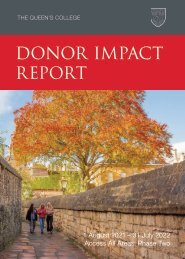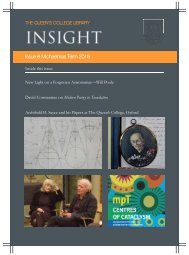Eagle Eye Magazine Issue 1 2023
Take a dive into the research and work that's going on at The Queen's College and beyond its walls within the community of Old Members. In issue one, we celebrate Shakespeare's First Folio, ask our history Fellows what makes them passionate about their subject, explore the new accessible Porters' Lodge, ask a current student about how to engage positively with climate issues, and much more.
Take a dive into the research and work that's going on at The Queen's College and beyond its walls within the community of Old Members. In issue one, we celebrate Shakespeare's First Folio, ask our history Fellows what makes them passionate about their subject, explore the new accessible Porters' Lodge, ask a current student about how to engage positively with climate issues, and much more.
You also want an ePaper? Increase the reach of your titles
YUMPU automatically turns print PDFs into web optimized ePapers that Google loves.
“Research has shown how to create<br />
hydrogenases for cleaner, accessible<br />
energy sources.<br />
ENZYMES INTO<br />
ELECTRICITY?<br />
Photo: iStock.com/Arthon Meekodong<br />
Recent graduate Jack Badley (Molecular and Cellular Biochemistry,<br />
2018) was part of a research team whose findings were recently<br />
published in top journal Nature. The team discovered an enzyme that<br />
converts air into energy.<br />
Analysis of a hydrogen-consuming enzyme from a<br />
common soil bacterium showed that it used low<br />
amounts of hydrogen in the atmosphere to create an<br />
electrical current. Here, Jack tells us more about the<br />
remarkable discovery and the role he played on the team.<br />
What started the research group thinking about the possibility<br />
of using an enzyme from common soil bacterium to convert<br />
air into energy?<br />
Hydrogenases are enzymes which reversibly convert molecular<br />
hydrogen into protons and electrons. These generated electrons<br />
can be utilised by cells to produce energy, similar to how we<br />
derive energy from glucose. Initially discovered in the 1930s,<br />
hydrogenases and hydrogenase-containing bacteria have been<br />
an invaluable resource for multiple biotechnological fields for<br />
some time. These include wastewater management, hydrogen<br />
production from cheap substrates like glucose, the direct<br />
production of clean and reproducible electricity from hydrogen via<br />
enzymatic biofuel cells, as well as cheaper and more eco-friendly<br />
methods to produce biologically active compounds like medicines.<br />
Despite the number of biotechnological processes that rely<br />
on these enzymes, there has been a significant challenge in<br />
utilising hydrogenases effectively. These enzymes evolved in<br />
an era when the Earth’s atmosphere had significantly higher<br />
hydrogen levels and very little oxygen. These two gas molecules<br />
are very similar in terms of shape, size, and charge meaning most<br />
enzymes have little means to separate them, which is a concern<br />
as oxygen is capable of binding to the same metal centre that<br />
normally converts hydrogen, but for a significantly longer period.<br />
Sometimes this even produces bi-product like hydrogen peroxide<br />
which can permanently damage the protein. Consequently,<br />
modern hydrogenases are extremely sensitive to oxygen inhibition,<br />
reducing or even halting their efficiency when exposed to air,<br />
significantly hindering their practical application.<br />
Since their discovery almost 90 years ago, countless research<br />
groups have been working hard to modify or discover<br />
hydrogenases that could function quickly and efficiently in<br />
atmospheric conditions, while maintaining the ability to<br />
specifically bind hydrogen strongly enough to source it from the<br />
extremely low atmospheric concentration. However, while great<br />
improvements were made, the level of discrimination between<br />
oxygen and hydrogen required to function efficiently when<br />
exposed to air was not able to come close to existing within<br />
any characterised lineage or variant of hydrogenase. However,<br />
in recent years, several high-affinity hydrogenase lineages have<br />
been discovered that show remarkable functionality in aerobic<br />
conditions with near-immunity to oxygen inhibition, efficiently<br />
converting hydrogen even at concentrations lower than those in<br />
our current atmosphere.<br />
Importantly, up until this project, no such oxygen-tolerant<br />
hydrogenase had been successfully isolated, making our group the<br />
first to successfully resolve one of their structures, which is vital<br />
in understanding how this immunity to oxygen is achieved for<br />
future study and the production of more efficient hydrogenasebased<br />
biotech. Grinter et al. successfully resolved the structure of<br />
Huc Hydrogenase from M. smegmatis, to a resolution which at the<br />
23

















